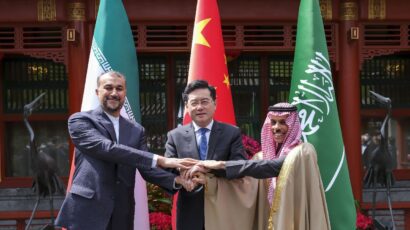Strategic planning comes to the State Department
By Gordon Adams | July 30, 2009
Can the State Department do a strategic plan and link it to setting budget priorities? We’re about to find out. Tucked away in the month’s news was a small, but important, announcement: The State Department and USAID are about to do something the Pentagon has done every four years since 1993–a quadrennial review. In this case, however, it will be a review of U.S. diplomatic strategy and development priorities, dubbed a Quadrennial Diplomacy and Development Review (QDDR).
This may sound wonky, but it could represent a badly needed step toward establishing planning and resource discipline in U.S. statecraft. And if it leads to stronger capabilities at State and USAID, it also might be an important step toward something I’ve been advocating for in these columns for two years now–a stronger civilian presence in U.S. foreign policy.
With more than 20 departments and agencies involved in foreign policy and little history of integrating diplomatic and development plans, planning has been a foreign concept in U.S. foreign policy.”
The review, which will take place over the next six months, will look at the international opportunities and challenges the United States faces; define U.S. diplomatic and development objectives and priorities; and outline strategies for achieving those objectives. Most importantly, the review will put in place the program and budget details that are needed to achieve the Obama administration’s top foreign policy and national security goals.
Until President Barack Obama took office in January, planning was a misnomer for how U.S. foreign policy budgets were put together. With more than 20 departments and agencies involved in foreign policy and little history of integrating diplomatic and development plans, planning has been a foreign concept in U.S. foreign policy. Some even would argue that the idea of “diplomatic planning” is an oxymoron–how do you “plan” for a world you cannot control?
But times have changed. Diplomacy is no longer restricted to “reporting, representing, and negotiating.” Today, U.S. diplomats are becoming mediators, administrators, program managers, contracting officers, governance advisers, and developers. And since the job has changed, planning has become central to everything a diplomat is expected to do. Hence, the need to create a strategic planning and budgeting culture at State/USAID–exactly what the QDDR aims to do.
That said, as the QDDR gets underway, there are eight things to watch for to make sure it’s a serious, effective effort to help foster such a culture and provide useful results:
- As Secretary of State Hillary Clinton noted when she announced the review’s creation, development and foreign assistance planning and diplomatic planning shouldn’t be done in isolation from each other. In fact, the two should be joined at the hip. My logic is as follows: The policy goals of U.S. diplomacy, sometimes called “short-term” goals, are firmly connected to the long-term U.S. goals of supporting effective governance and economic development throughout the world. Therefore, they ought to be strategized together, and our long-term development investments ought to be a major priority of U.S. foreign policy strategy.
- Planning and budgeting for the people and infrastructure who make up State and USAID should be tied to program planning and funding. For decades, the “operations” side of State (its staff, IT, security, buildings, and administration) has been budgeted separately from the foreign assistance and development programs it implements. But people and infrastructure should be, in part, guided by the realities of our new diplomacy. In other words, the programs cannot be executed without recruiting people with the right skills, restructuring personnel training programs to fit the new missions, and rewarding and promoting staff for choosing career paths that give them professional experience across multiple agencies.
- The planning shouldn’t deteriorate into a theoretical exercise about policy, diplomacy, and development devoid of any reference to resources. Past Defense Department quadrennial reviews weren’t particularly useful because they paid no attention to resource limits and ended up as “blue-sky” exercises. No agency likes to admit that there are limits to resources–something Defense has gotten away with for a decade. But if State makes this mistake, its plans will become wish lists and create unreachable goals without establishing any priorities, discrediting the planning process. Budget constraints are real and, in planning, they should force real priorities.
- The review process should start with policy guidance from the top. If State and USAID simply begin with sub-agency wish lists, everyone’s goals will be equal and the strategic plan will suffer. That said, the field operations need to be connected to the process. The staff at U.S. embassies across the world comprises the people who ultimately will execute the plan, apply the resources, and deliver the programs. Thus, within reason, the review and planning processes need to flow in both directions.
- Staff the QDDR adequately. The initial briefing on the review said 10-12 people would work on it. While State doesn’t need the cast of thousands Defense uses to do its review and budget planning, a dozen or so people is probably too few to be effective. In addition, the staffing should be internal, not contracted out. If a consulting firm does the work, the permanent residents at State won’t own the process, and nobody will be wedded to the plan.
- If State truly is going to recover its foreign policy leadership and provide both adequate balance to, and effective partnership with, Defense, it must be connected to other executive-branch planning processes. An historic weakness of the Defense reviews is that, at best, they have put diplomacy and foreign assistance at the margins. Such insularity is a mistake. To make sure it doesn’t do the same, State should provide input for Defense’s review and vice versa. Additionally, there’s a diaspora of government agencies that are part of U.S. foreign engagement–the Justice Department, the Treasury Department, the Department of Human Health and Services, the Agriculture Department, and the Centers for Disease Control and Prevention to name a few. The QDDR needs to bring them to the table, or the plan won’t reflect the full range of U.S. global activity. Finally, both Defense and State’s reviews need to be linked to a broader National Security Council/Office of Management and Budget-led effort setting overall priorities and guidance for U.S. foreign policy and national security strategy. There’s little public evidence that such a process is taking place in the White House today, but both the Defense and State’s review efforts will be flawed if there isn’t some prioritization coming from the executive branch.
- Make no mistake, however: The objective of the planning exercise shouldn’t be to create a State Department that can work more closely with Defense. While a closer working relationship is desirable (witness the mess in Iraq and Afghanistan when the relationship didn’t exist), State’s planning shouldn’t be driven by what the Joint Chiefs think are their most pressing concerns. The QDDR needs to set broad, civilian-oriented goals for U.S. foreign policy and national security strategy, which military planning can support as needed, not the other way around.
- Although there’s no guarantee that every review will be meaningful and effective, the QDDR needs to become a regular exercise. Otherwise, no lessons will be learned from doing it and the next administration will create a different mousetrap, or no mousetrap at all. Plus, it’s critical to use this first QDDR to put State/USAID on the road to culture change. To guarantee that the QDRR takes place on a set schedule, Congress should require that a QDDR be part of the permanent statute governing U.S. foreign relations.
It’s far too soon to tell whether the announcement of the QDDR truly will transform the way Washington plans, budgets, and carries out its foreign policy and national security strategy. As always, there’s a chance it could be just another failed effort to bring coherence to the relative anarchy of our foreign policy institutions. But we’ll have a good sense of whether the review is going to succeed or fail in the next six months.
Together, we make the world safer.
The Bulletin elevates expert voices above the noise. But as an independent nonprofit organization, our operations depend on the support of readers like you. Help us continue to deliver quality journalism that holds leaders accountable. Your support of our work at any level is important. In return, we promise our coverage will be understandable, influential, vigilant, solution-oriented, and fair-minded. Together we can make a difference.
Topics: Columnists















